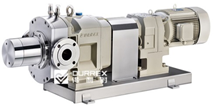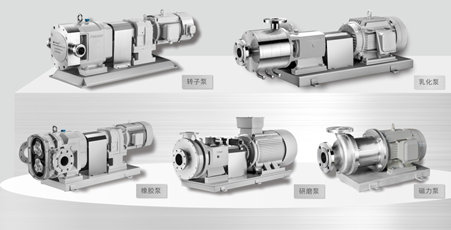
Privacy statement: Your privacy is very important to Us. Our company promises not to disclose your personal information to any external company with out your explicit permission.
The most widely used process pumps are Rotor Pumps, centrifugal pumps, screw pumps, etc. The following will explain the principles, advantages and disadvantages of rotor pumps, centrifugal pumps, and screw pumps.

Definition
Rotary lobe pumps, also known as colloid pumps, cam pumps, three leaf pumps, or universal transport pumps, belong to the category of volumetric pumps. It achieves the purpose of conveying fluid through the periodic conversion of multiple fixed volume conveying units in the working chamber.
2 Centrifugal pumps
The working principle of a centrifugal pump is centrifugal motion. Centrifuge is actually a manifestation of the inertia of an object, such as the water droplets on an umbrella. When the umbrella slowly rotates, the water droplets will follow the umbrella's rotation, because the frictional force between the umbrella and the water droplets acts as a centripetal force for the water droplets. But if the umbrella rotates faster, the frictional force is not enough to make the water droplets move in a circular motion, then the water droplets will detach from the outer edge of the umbrella and move in a circular motion, just like using a rope to pull a stone. If the speed is too fast, the rope will break and the stone will fly out, which is called centrifugation.
When a centrifugal pump is working, the high-speed rotating impeller blades drive the liquid to rotate, throwing it out, thereby achieving the purpose of transportation. Before working, the pump body and inlet pipe of a centrifugal pump must be filled with liquid to form a vacuum state. When the impeller rotates rapidly, the blades cause the liquid to rotate quickly. The rotating liquid flies away from the impeller under the action of centrifugal force. After the liquid inside the pump is thrown out, the central part of the impeller forms a vacuum area, and the external liquid is pressed into the inlet pipe through the pipeline network under atmospheric pressure. In this way, continuous conveying can be achieved through continuous circulation.
3 Screw pumps
Screw pump is a new type of pump that operates according to the principle of rotary meshing displacement. Its main working components are eccentric screw (rotor) and fixed sleeve (stator). Due to the special geometric shape of these two components, they form separate sealed cavities, and the medium is uniformly pushed and flows in the axial direction. The internal flow rate is low, the volume remains unchanged, and the pressure is stable, so there will be no vortex or agitation.
Comparison of advantages and disadvantages
1 Comparison between screw pump and centrifugal pump
1) When gas enters the pump cavity, centrifugal pumps operate very unstable, greatly reducing efficiency, causing loud pump noise and vibration, and severe cavitation. Screw pumps can effectively achieve mixed transportation of gases, liquids, and solids.
2) Centrifugal pumps generally have high rotational speeds, up to thousands of revolutions per minute, and exhibit significant shear resistance to the medium; Screw pumps generally operate at low speeds to ensure no pulse or vibration, achieving shear free conveying.
3) Centrifugal pumps transport media. Once the media becomes viscous, there will be a sharp decrease in flow or pressure. Screw pumps are more suitable for conveying media with high viscosity and high solid content.
2 Comparison between rotor pump and single screw pump
1) The rotor pump can idle, which is particularly important in the event of sudden material interruption or operational errors to prevent pump damage and ensure safe operation.
2) The Lobe Pumps has a small volume, which is one-third of the installation area of a single screw pump, reducing the scope and cost of civil engineering.
3) The rotor pumps can achieve online maintenance without dismantling the pipeline, which is convenient and fast, reducing downtime.
4) The non-extrusion working principle of the rotor pump, with an adjustable casing design, extends the service life, reduces maintenance times, and saves on spare parts costs.

Durrex pumps as a research and manufacturing enterprise for non-Newtonian fluid conveying equipment, obtained 56 national patents, including 11 invention patents, has developed Emulsification pump, Homogeneous Pumps, Lobe pumps, Rotor pumps, homogeneous pumps, rotor pumps, and other products which through excellent quality through first-class production and testing equipment, and is providing fluid conveying equipment and technical services for more than 10,000 users worldwide.

Privacy statement: Your privacy is very important to Us. Our company promises not to disclose your personal information to any external company with out your explicit permission.

Fill in more information so that we can get in touch with you faster
Privacy statement: Your privacy is very important to Us. Our company promises not to disclose your personal information to any external company with out your explicit permission.